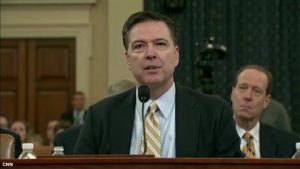“Come back to October 28th with me and stare at this, and tell me—what would you do?”
Earnest words. A touch of drama, a dash of urgency. The speaker faces the group. The group listens and considers what next to think, to do, to say.
The speaker was FBI Director James Comey. The group was a Senate committee. The scene was yesterday, at the US Capitol, testimony on the director’s decisions and the Bureau’s conduct during the presidential campaign and election of 2016.
But as I watched a video clip of the moment and read an article about the event in today’s Wall Street Journal, a thought formed in my mind:
That could have been me.
I say that because Comey’s statement and question strikes at the core of my methods. The people who participate in my workshops, seminars, coaching sessions, and group presentations are faced with a similar question. I ask my version of Comey’s remark—”it’s this moment, on this day and time, in this setting, and as a leader you’ve got to decide what you’re going to do”—and my clients offer their views, their reasoning, their expectations.
I know it may not seem much to you in reading my description but let me assure you that it’s actually quite gripping and compelling. I’ve watched as people lean forward, move up in their seats, and show an intensity and degree of involvement that would likely surprise you. They relish this type of history and this type of learning and enrichment for their leadership.
You could be Martin Luther King Jr and at a few minutes before midnight before Good Friday, 1963 you’ve just received word during a late-night team meeting that your organization is out of money despite tomorrow’s planned protest where dozens will be arrested…what do you do?
You could be Abraham Lincoln and on a train to Gettysburg to deliver formal remarks when, while at a brief stop for the train to take on water, you hear a hundred people yelling for you to give a quick speech…what do you do?
You could be Ronald Reagan and in a small office next to the Oval Office watching a television report of a space shuttle’s explosion and the shocking death of the crew five minutes ago…what do you do?
You could be Katharine Graham at a private lunch meeting with one of your young and talented reporters who work at your newspaper and he asks if you want him to divulge his secret source for an investigative story he’s writing about the President of the United States…what do you do?
And on and on and on. Countless moments from the past can be brought to life with the proper handling. When the past is forged into history—which must mean a respect for the embedded sub-word “story”—then the listener, the reader, the viewer can gain insight and perspective for their leadership in the here-and-now.
My thanks to James Comey.








